Electrical Circuit Flashover Model of Polluted Insulators under AC Voltage Based on the Arc Root Voltage Gradient Criterion
Abstract
:1. Introduction
2. Basic AC Mathematical Flashover Model of Polluted Insulators
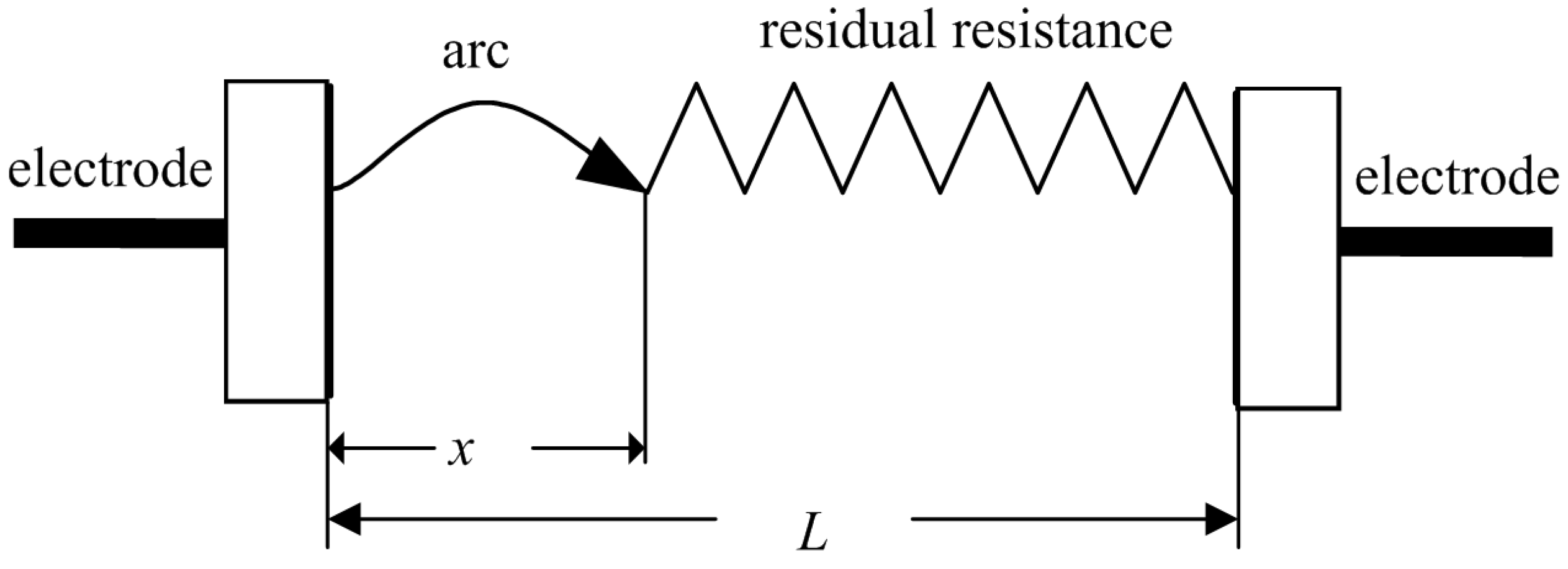
3. Arc Root Voltage Gradient Variation during Arc Propagation
3.1. The Arc Root Voltage Gradient Variation during Arc Propagation
3.2. The Arc Root Voltage Gradient Criterion

4. Pollution Flashover Model based on Arc Root Voltage Gradient Criterion
4.1. Basic Concept

4.2. The Calculation Flowchart of Modeling

4.3. The Calculation of Arc Root Voltage Drop

4.4. Critical Flashover Voltage
4.4.1. The Derivation of Critical Flashover Voltage
4.4.2. The Calculation of Critical Flashover Voltage
5. Model Validation and Discussion
5.1. The Comparison of the Flashover Voltage
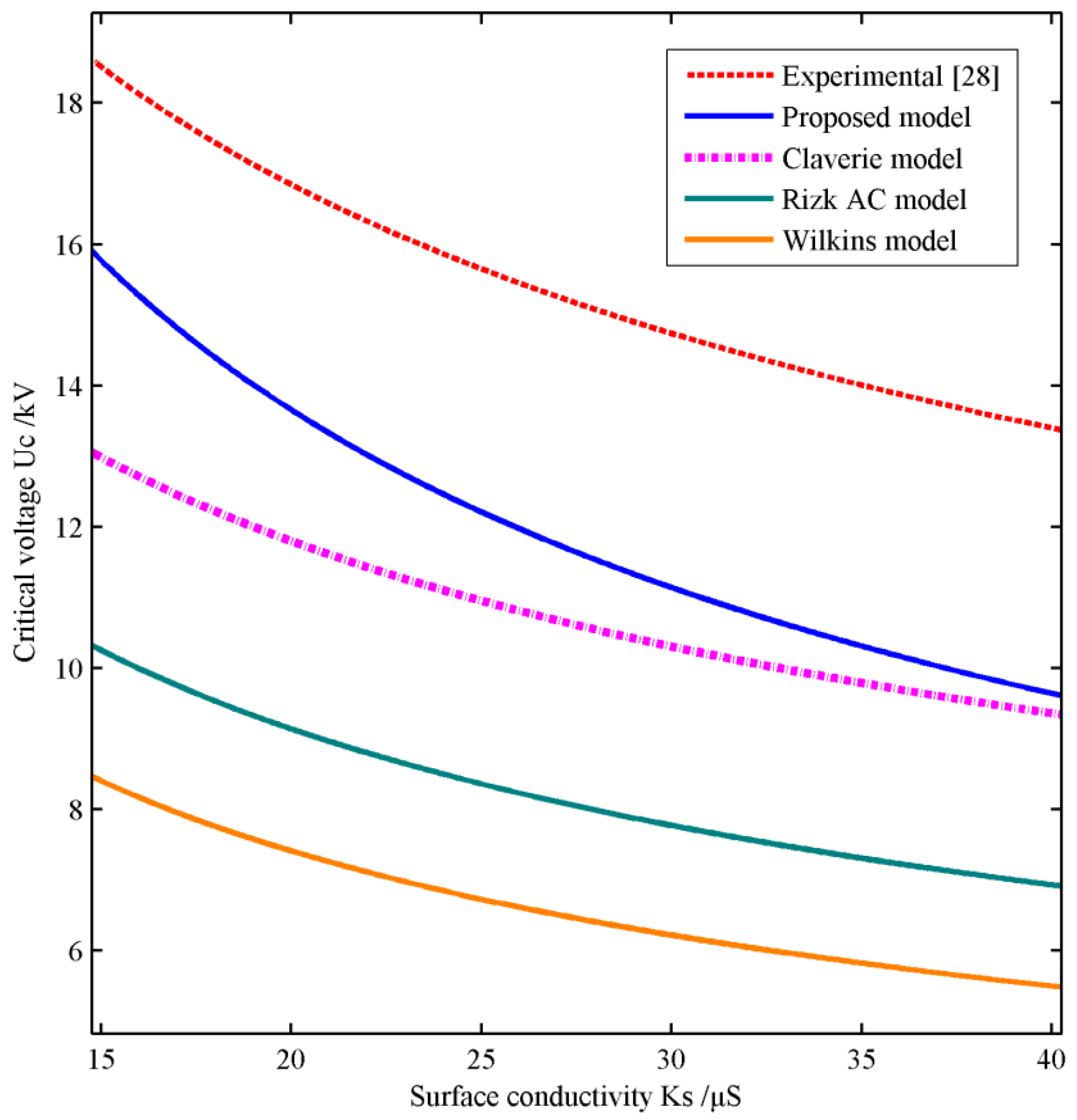
5.2. The Comparison of the Flashover Current
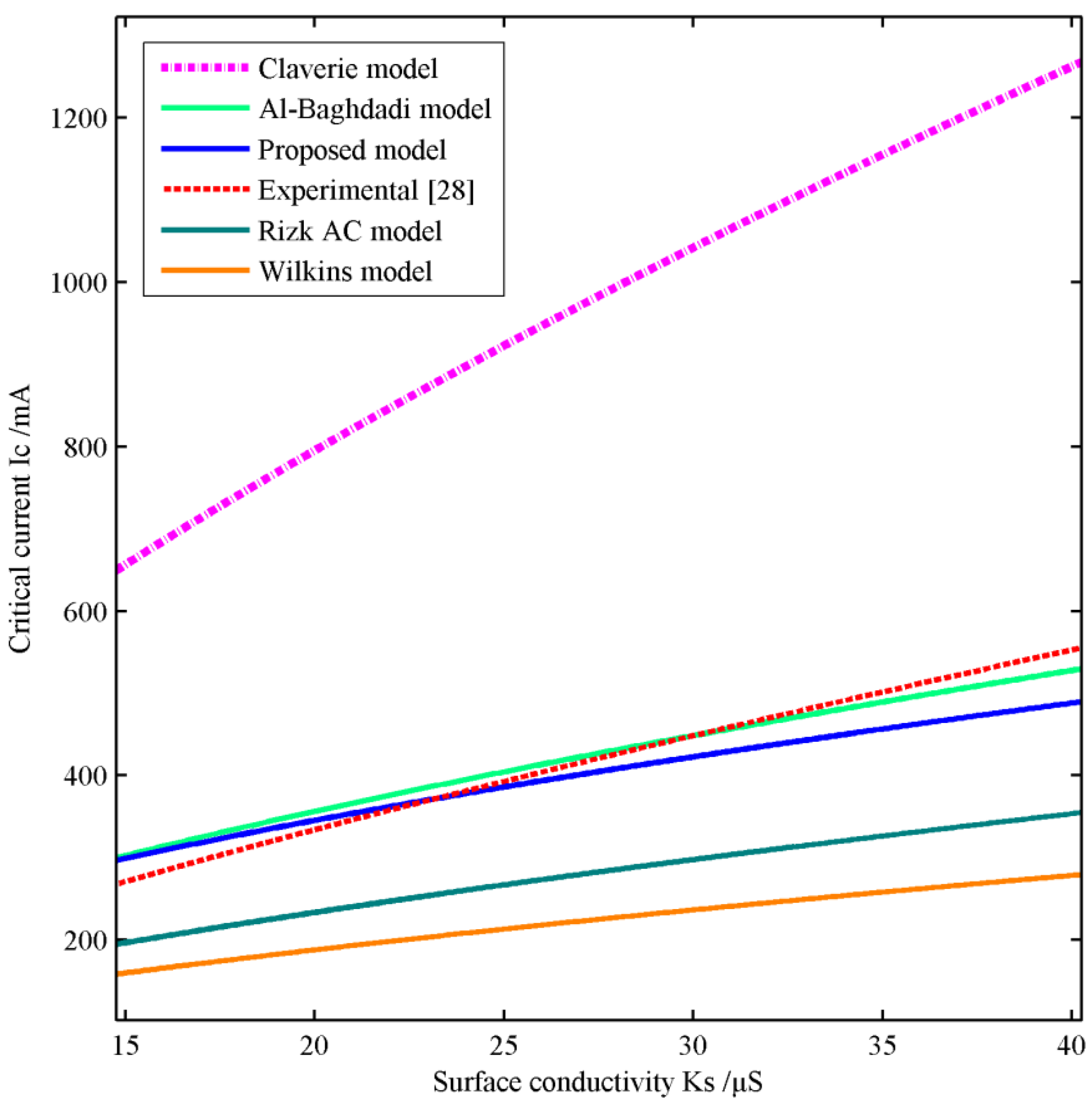
5.3. The Comparison with the Artificial AC Pollution Flashover Tests
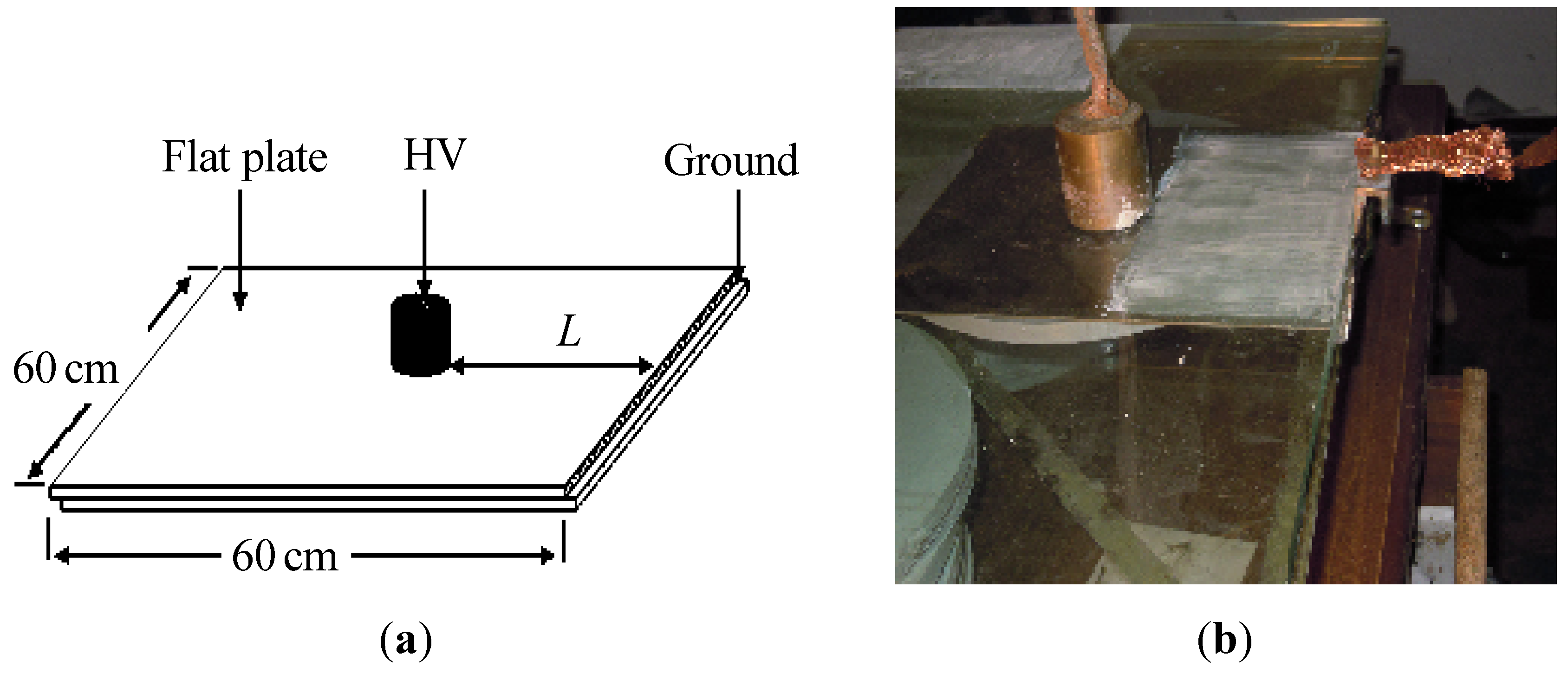
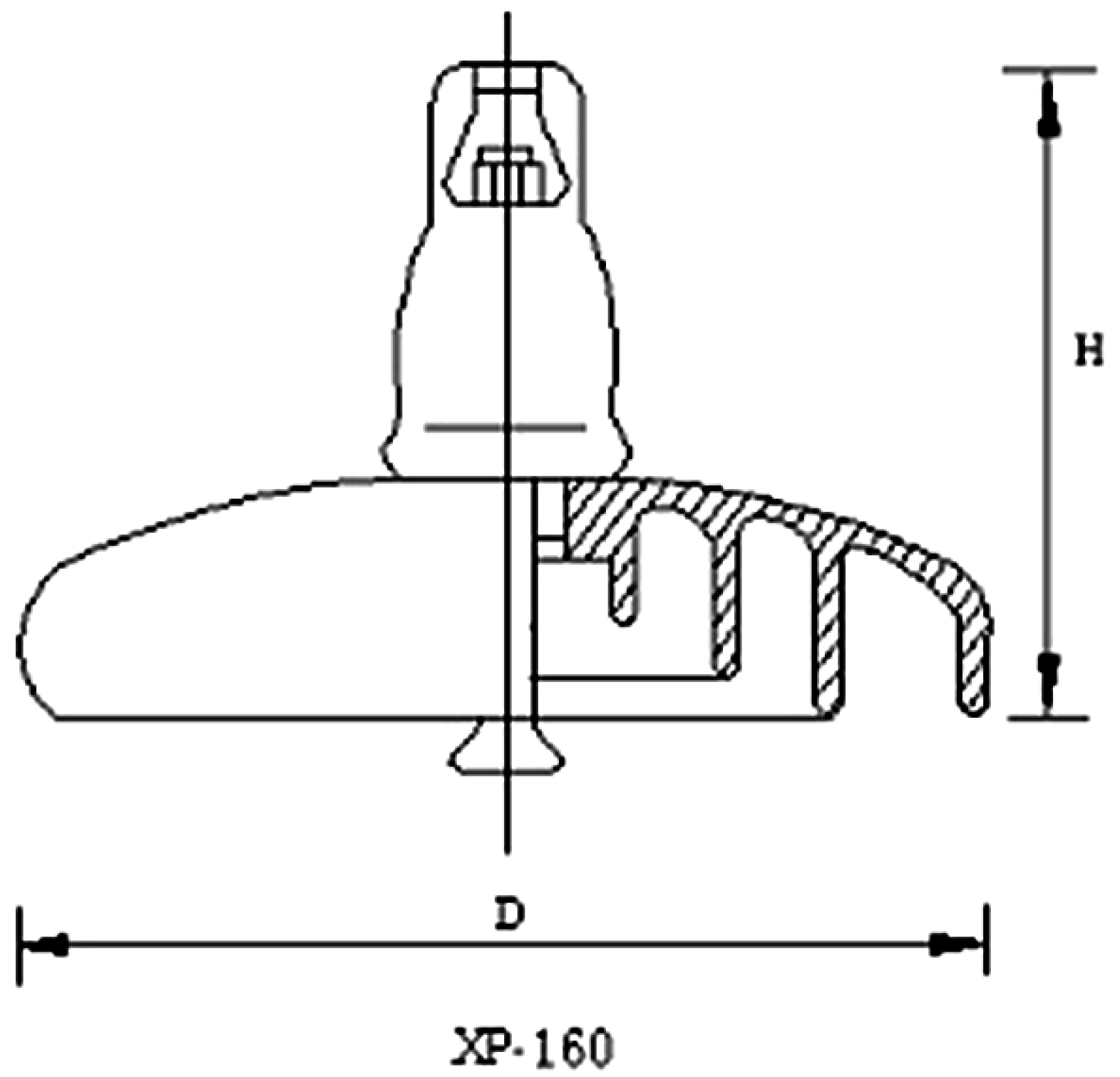
| L = 8 cm | 0.1 mg/cm2 | 0.14 mg/cm2 | 0.2 mg/cm2 | 0.28 mg/cm2 |
|---|---|---|---|---|
| Experiment | 3.5 kV | 3.0 kV | 2.6 kV | 2.4 kV |
| Calculation | 3.6 kV | 3.2 kV | 2.7 kV | 2.3 kV |
| Error | 2.8% | 6.2% | 3.7% | 4.3% |
| L = 10 cm | 0.1 mg/cm2 | 0.14 mg/cm2 | 0.2 mg/cm2 | 0.28 mg/cm2 |
| Experiment | 4.7 kV | 4.1 kV | 3.6 kV | 2.7 kV |
| Calculation | 4.5 kV | 4.0 kV | 3.4 kV | 2.9 kV |
| Error | 4.4% | 2.5% | 5.9% | 6.9% |
| L = 12 cm | 0.1 mg/cm2 | 0.14 mg/cm2 | 0.2 mg/cm2 | 0.28 mg/cm2 |
| Experiment | 5.7 kV | 4.4 kV | 4.2 kV | 3.7 kV |
| Calculation | 5.5 kV | 4.7 kV | 4.0 kV | 3.5 kV |
| Error | 3.6% | 6.4% | 5.0% | 5.7% |
| L = 8 cm | 0.1 mg/cm2 | 0.14 mg/cm2 | 0.2 mg/cm2 | 0.28 mg/cm2 |
|---|---|---|---|---|
| Experiment | 0.3081 A | 0.3477 A | 0.4095 A | 0.4794 A |
| Calculation | 0.3138 A | 0.3602 A | 0.4228 A | 0.4910 A |
| Error | 1.8% | 3.5% | 3.1% | 2.4% |
| L = 10 cm | 0.1 mg/cm2 | 0.14 mg/cm2 | 0.2 mg/cm2 | 0.28 mg/cm2 |
| Experiment | 0.3216 A | 0.3781 A | 0.4111 A | 0.503 A |
| Calculation | 0.3138 A | 0.3602 A | 0.4228 A | 0.4910 A |
| Error | 2.5% | 5.0% | 2.8% | 2.4% |
| L = 12 cm | 0.1 mg/cm2 | 0.14 mg/cm2 | 0.2 mg/cm2 | 0.28 mg/cm2 |
| Experiment | 0.3247 A | 0.3616 A | 0.4105 A | 0.4986 A |
| Calculation | 0.3138 A | 0.3602 A | 0.4228 A | 0.4910 A |
| Error | 3.5% | 0.4% | 2.9% | 1.5% |
| Product model | Diameter | Structure height | Creepage distance | Coefficient of form |
|---|---|---|---|---|
| XP-160 | 255 mm | 146 mm | 305 mm | 0.7 |
| Product model | Diameter | Structure height | Creepage distance | Coefficient of form |
|---|---|---|---|---|
| XP1-160 | 280 mm | 170 mm | 370 mm | 0.8 |
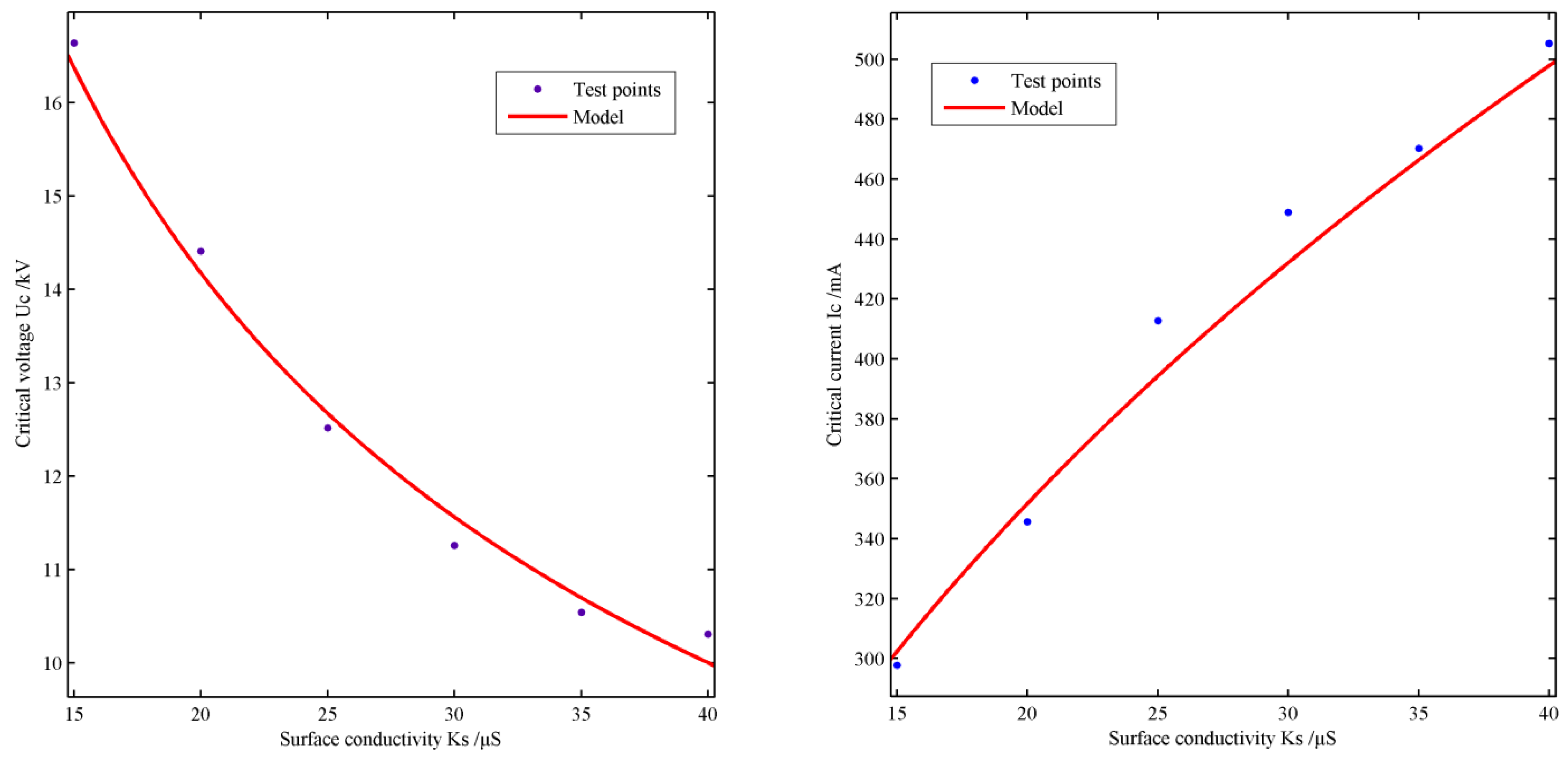
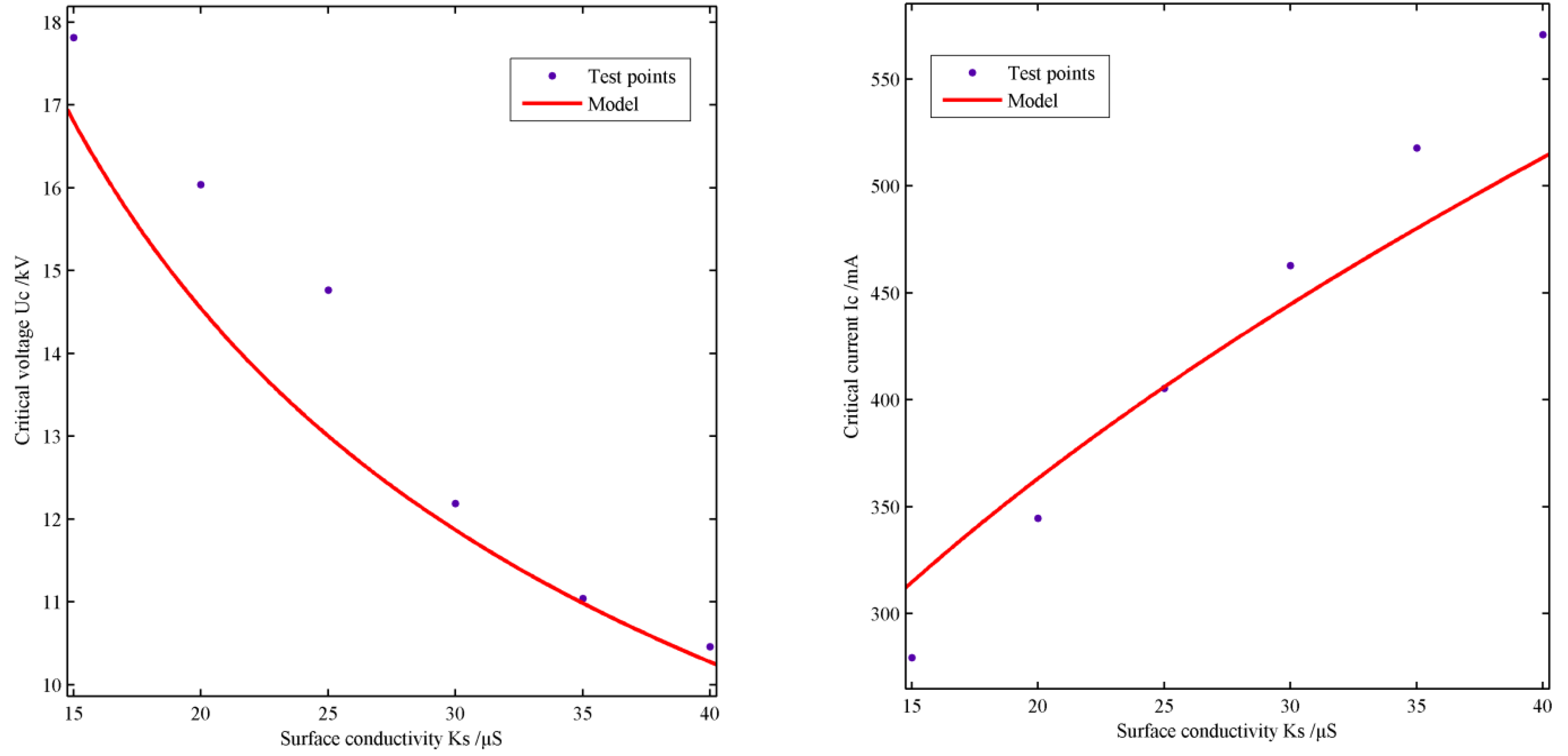
6. Conclusions
Acknowledgments
References
- Obenaus, F. Contamination flashover and creepage path length. Dtsch. Elektrotechnik 1958, 12, 135–136. [Google Scholar]
- Rizk, F.A.M. Mathematical models for pollution flashover. Electra 1981, 78, 71–103. [Google Scholar]
- Wilkins, R. Flashover of high voltage insulators with uniform surface pollution films. IEE Proc. Gener. Transm. Distrib. 1969, 116, 457–465. [Google Scholar]
- Alston, L.L.; Zoeledziowski, S. Growth of discharge on pollution insulation. IEE Proc. Gener. Transm. Distrib. 1963, 110, 1206–1266. [Google Scholar]
- Gopal, S.; M.E.; Rao, Y.N. Flashover phenomena of polluted insulators. IEE Proc. 1984, 131, 140–143. [Google Scholar]
- Sundararajan, R.; Gorur, R.S. Dynamic arc modeling of pollution flashover if insulators under DC voltage. IEEE Trans. Electr. Insul. 1993, 26, 209–218. [Google Scholar] [CrossRef]
- Dhahbi-Megriche, N.; Beroual, A. Flashover Dynamic model of polluted insulators under AC voltage. IEEE Trans. Dielectr. Electr. Insul. 2000, 7, 283–289. [Google Scholar] [CrossRef]
- Beroual, A. Electronic and gaseous processes in the prebreakdown phenomena of dielectric liquids. J. Appl. Phys. 1993, 73, 4528–4533. [Google Scholar] [CrossRef]
- Beroual, A.; Fofana, I. Modelling of the leader and the return stroke currents with an equivalent electrical network. In Proceedings of the 9th International Symposium on High Voltage Engineering, Graz, Austria, 28 August–1 September 1995. Paper 2141.
- Beroual, A. Universal dynamic model of discharge propagating in air, liquids, solid/liquid interfaces and polluted. In Proceedings of the 13th International Symposium on High Voltage Engineering, Delft, The Netherlands, 25–29 August 2003.
- Beroual, A.; Dhahbi-Megriche, N. Dynamic model of discharge propagation on polluted surfaces under impulse voltages. IEE Proc. Gener. Transm. Distrib. 2000, 147, 279–284. [Google Scholar] [CrossRef]
- Beroual, A.; Dhahbi-Megriche, N.; Krahenbuhl, L. A new proposal model for flashover of polluted insulators. J. Phys. D 1997, 30, 889–894. [Google Scholar] [CrossRef]
- Slama, M.E.; Beroual, A.; Hadi, H. Analytical computation of discharge characteristic constants and critical parameters of flashover of polluted insulators. IEEE Trans. Dielectr. Electr. Insul. 2010, 17, 1764–1771. [Google Scholar] [CrossRef]
- Li, J.Y.; Sun, C.X.; Sima, W.X.; Yang, Q.; Hu, J.L. Contamination level prediction of insulators based on the characteristics of leakage current. IEEE Trans. Power Deliv. 2010, 25, 417–424. [Google Scholar]
- Li, J.Y.; Sima, W.X.; Sun, C.X.; Sebo, S.A. Use of leakage currents of insulators to determine the stage characteristics of the flashover process and contamination level prediction. IEEE Trans. Dielectr. Electr. Insul. 2010, 17, 490–501. [Google Scholar] [CrossRef]
- Claverie, P. Predetermination of the behavior of polluted insulators. IEEE Trans. Power Appar. Syst. 1971, 90, 1902–1908. [Google Scholar] [CrossRef]
- Claverie, P.; Porcheron, Y. How to choose insulators for polluted areas. IEEE Trans. Power Appar. Syst. 1973, 92, 1121–1131. [Google Scholar] [CrossRef]
- Rizk, F.A.M. Analysis of dielectric recovery with reference to dry-zone arcs on polluted insulators. In Proceedings of the IEEE Power Engineering Society Winter Power Meeting, New York, NY, USA, 28 January–2 February 1971; Volume 90, p. 134.
- Rizk, F.A.M. A criterion for AC flashover of polluted insulators. In Proceedings of the IEEE Power Engineering Society Winter Power Meeting, New York, NY, USA, 28 January–2 February 1971; Volume 90, p. 135.
- Hampton, B.F. Flashover mechanism of polluted insulation. IEE Proc. Gener. Transm. Distrib. 1964, 111, 985–990. [Google Scholar]
- Nacke, H. Stability of foreign layer discharges and theory of contamination flashover. ETZ-A 1966, 87, 577–585. [Google Scholar]
- Jolly, D.C. Contamination flashover, part1: Theoretical aspects. IEEE Trans. Power Appar. Syst. 1972, 91, 2437–2442. [Google Scholar] [CrossRef]
- Wilkin, R.; Al-Baghdadi, A.A.J. Arc propagation along an electrolyte surface. Proc. Instit. Electr. Eng. 1971, 1, 1886–1891. [Google Scholar] [CrossRef]
- Mercure, H.P.; Drouet, M.G. Dynamic measurements of the current distribution in the foot of an arc propagation along the surface of an electrolyte. IEEE Trans. Power Appar. Syst. 1982, 101, 725–732. [Google Scholar] [CrossRef]
- Fofana, I.; Beroual, A. A model for long air gap discharge using an equivalent electrical network. IEEE Trans. Dielectr. Electr. Insul. 1996, 3, 273–282. [Google Scholar] [CrossRef]
- Mekhaldi, A.; Namane, D.; Bouazabia, S.; Beroual, A. Flashover of discontinuous pollution layer on HV insulators. IEEE Trans. Dielectr. Electr. Insul. 1999, 6, 900–906. [Google Scholar] [CrossRef]
- Ghosh, P.S.; Chatterjee, N. Arc propagation over electrolytic surfaces under power frequency voltage. IEEE Trans. Dielectr. Electr. Insul. 1996, 3, 529–536. [Google Scholar] [CrossRef]
- Topalis, F.V.; Gonos, I.F.; Stathopulos, I.A. Dielectric behavior of polluted porcelain insulators. IEE Proc. Gener. Transm. Distrib. 2001, 148, 269–274. [Google Scholar] [CrossRef]
© 2012 by the authors; licensee MDPI, Basel, Switzerland. This article is an open access article distributed under the terms and conditions of the Creative Commons Attribution license (http://creativecommons.org/licenses/by/3.0/).
Share and Cite
Yang, Q.; Wang, R.; Sima, W.; Jiang, C.; Lan, X.; Zahn, M. Electrical Circuit Flashover Model of Polluted Insulators under AC Voltage Based on the Arc Root Voltage Gradient Criterion. Energies 2012, 5, 752-769. https://doi.org/10.3390/en5030752
Yang Q, Wang R, Sima W, Jiang C, Lan X, Zahn M. Electrical Circuit Flashover Model of Polluted Insulators under AC Voltage Based on the Arc Root Voltage Gradient Criterion. Energies. 2012; 5(3):752-769. https://doi.org/10.3390/en5030752
Chicago/Turabian StyleYang, Qing, Rui Wang, Wenxia Sima, Chilong Jiang, Xing Lan, and Markus Zahn. 2012. "Electrical Circuit Flashover Model of Polluted Insulators under AC Voltage Based on the Arc Root Voltage Gradient Criterion" Energies 5, no. 3: 752-769. https://doi.org/10.3390/en5030752




